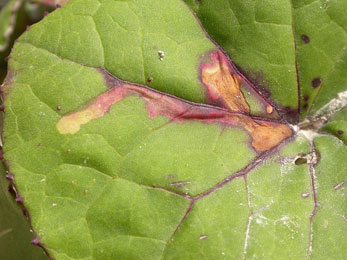|
||||||
|
Scrobipalpula
tussilaginis (Stainton, 1867) Colt's-foot Groundling Gelechia
tussilaginis
Stainton, 1867. Mitt. Schweiz. ent.
Ges. 3: 294. |
|||||||||||||||||||||||||||||||||||||||||||||||||
Leaf-miner: The larva mines the leaves creating an irregular blotch (UKMoths). Forms an upper surface mine, with the surounding area turning purple. The frass is accumulated in one place in the mine and the larva may conceal itself under this (British leafminers). Initially a branching corridor, later more an elongate upper-surface blotch from the leaf base to the leaf margin, finally occupying a good part of the leaf. Most frass is deposited in one section of the mine, forming a crust below which the very agile larvae can retreat (Bladmineerders van Europa).
Larva: The larvae of moths have a head capsule and chewing mouthparts with opposable mandibles (see video of a gracillarid larva feeding), six thoracic legs and abdominal legs (see examples). The larva of tussilaginis is apple green; head and prothoracic plate dark brown; full-grown larva with rose-red segment limits (Pelham-Clinton, 1989a) (Bladmineerders van Europa). Pupa: The pupae of moths have visible head appendages, wings and legs which lie in sheaths (see examples). Adult: The adult is illustrated in UKMoths by John Walters. The species is included in mothdissection.co.uk. Hosts in Great Britain and Ireland:
Hosts elsewhere:
Time of year - larvae: August - September, but two generations occur in Britain, in July and October - November (Bladmineerders van Europa). Time of year - adults: There are two generations, moths on the wing in June and July and again in August and September (UKMoths; British leafminers). Distribution in Great Britain and Ireland: A scarce and very local species, only discovered in Britain in 1983 where it was found on the coast in south Devon. It is now known to occur in a few localities eastwards to Hampshire on sparsely vegetated coastline (UKMoths; Dorset, South Devon and South Hampshire (NBN Atlas). Distribution elsewhere: Widespread in continental Europe including Austria, Czech Republic, French mainland, Germany, Greek mainland, Hungary, Italian mainland, Macedonia, Poland, Romania, Russia - East, Slovakia, Slovenia, Switzerland, The Netherlands and Ukraine (Fauna Europaea). NBN Atlas links to known host species:
British and Irish Parasitoids in Britain and elsewhere:
|
|||||||||||||||||||||||||||||||||||||||||||||||||
| Last updated 19-Oct-2019 Brian Pitkin | ||

